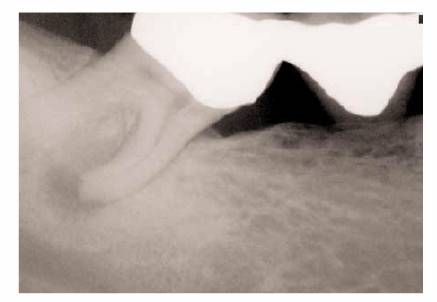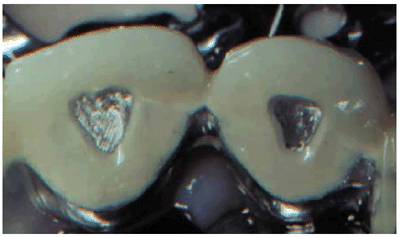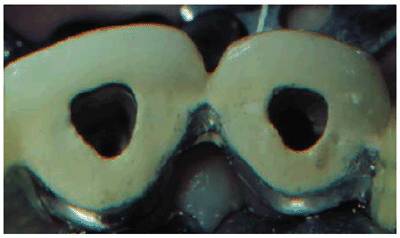ENDODONTICS AND ESTHETIC DENTISTRY(13)
Procedure
If the tooth that needs an endodontic treatment has a full-coverage restoration, special care must be taken prior to cutting access preparation because in many cases, the "artificial" tooth structure could be very different from the natural tooth, both in regard to size and shape and the occlusal plane (Figure 19-48). The preoperative radiograph(s) and careful probing with a periodontal probe around the cervical area of the tooth will give some indications.

Figure 19-48: Mesially inclined mandibular second molar. Because of the tilt, the direction of the bur should be angled toward the distal to avoid a perforation during access cavity preparation.
Natural tooth structure should be protected from heat. Studies have shown that deleterious crazing and cracking occur in the enamel and in the dentin when access cavities are prepared dry. Regardless of the fact that the pulp will be extirpated, water should be used to cool both the bur and the tooth during access preparation.
Burs
Penetration and funneling are the two phases of cavity preparation. This can be accomplished with a round #2 or #4 bur for penetration, followed by a #1558 or #701 fissure bur for funneling. Alternatively, the funneling could be done with an Endo-Z bur (DENTSPLY/Maillefer,
Removal of existing occlusal and proximal restorations should be completed prior to entering the pulp chamber. Besides providing a direct view, it also saves time and eliminates the chance that loose particles from the restoration are entering the canal, thereby preventing negotiation to full length. The only exception to this is if removing deep, but sound, proximal extension of the restoration will compromise the rubber dam seal.
Restored Teeth. To facilitate canal orientation, it may be beneficial to gain access and locate the orifices of the canals prior to placing the rubber dam because then the root eminence of the alveolar bone could be observed and used as a guide. It is important, as always, to place the rubber dam before introducing an endodontic file into the tooth to eliminate the possibility of the aspiration or ingestion of the file.
Acrylic Veneer and Full Metallic Crowns. A new #2 round or #1558 round end fissure bur is preferred when penetrating gold. The sharpness of a new bur will maximize penetration and minimize the tendency to skip or skid. As mentioned, the access opening must be large enough to allow visualization of the entire chamber, location of the root canal orifice(s), and removal of all existing decay.
Access through nonprecious metal crowns requires the use of a coarse dome-shaped cylindrical diamond bur. Stokes et al. found that the Horico 139x012 (Pfingst,
Aluminous Porcelain. Medium- or fine-cut diamonds accompanied by a water spray should be used to cut through porcelain.21 Carbide burs will generate incredible heat, and the cutting action of the bur will significantly increase the possibility of porcelain failure. The operator has the choice of a round diamond stone (Premier 120F, Premier Dental Products, King of Prussia, PA, or Gnathos 801-016, Gnathos Dental Products, Weston, MA), a round end fissure diamond stone (Premier 982.8, Premier Dental Products), or a pear-shaped diamond (Premier 365.4F, Premier Dental Products). Disposable diamonds are efficient when cutting porcelain or all ceramic restorations. Being new, they tend to reduce crazing or cracking in the restoration and generate less heat (eg, Gnathos 801-016).
Porcelain Fused-to-Metal Crown. A round diamond stone (Premier 120F or Gnathos 801-016) accompanied by a copious water spray is best for the porcelain entry. A classic access cavity is traced in the porcelain (Figure 19-49A). Penetration through the metal and dentin and into the pulp chamber is accomplished with a new #2 or #1558 carbide bur (Figure 19-49B). Carbide burs dull rapidly and should be discarded when they lose their cutting efficiency.

Figure 19-49A: Outline of access cavity traced through porcelain with a diamond stone.

Figure 19-49B: Penetration and funneling of access cavity completed with a carbide bur.
All-Ceramic Crowns. A laboratory study has shown that high-speed diamond instrumentation with water spray is efficient when cutting through Cerestore crowns (3M ESPE, St. Paul, MN).30 The same study also indicated that carbide burs used under similar conditions were inefficient. More specifically, when preparing access cavities in cast glass crown, a diamond stone should be selected (eg, Premier 120F, Gnathos 801-016).
Porcelain Inlays and Onlays. A two-fold problem presents with these restorations vis-a-vis access preparation: fragility of the material and design of the restoration.
Fracture and dislodgment are potential sequelae when cutting into these restorations. To avoid the problem, one must be certain of the pulpal health prior to selecting these restorations. If faced with endodontic therapy through these restorations, however, the patient must be advised of the possibility of replacement. Once the risk is accepted, high-speed diamond instrumentation (Brasseler 801-016 [Brasseler,
- on 01.11.2012 [endodontics]
- on 01.11.2012 [endodontics]
- on 01.11.2012 [endodontics]
- on 10.13.2011 [endodontics]
- on 12.15.2010 [endodontics]
- on 08.11.2010 [endodontics]
- Long Island College Hospital - [education]
- Faculty of Dental Medicine - H [education]
- The American Association of Or [organize]
- Summer Institute in Clinical D [organize]
- Academy of Osseointegration [organize]
- University of North Carolina a [education]
- American Orthodontic Society [article]
- American Equilibration Society [article]
- Niigata University - Japan [education]
- University of Buffalo [education]